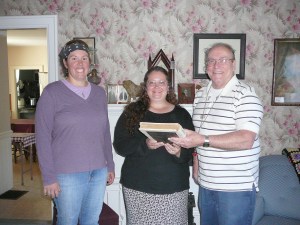STRONG — Two books found in a cardboard box in the back of the library have generated excitement for the local Historical Society.
Strong Elementary School Librarian Jami Badershall was cleaning the back room of the library, and she started going through cardboard boxes. She found two old books, both in fragile condition, but she didn’t know what to do with them.
“I just left them there for awhile, but I thought I should do something,” Badershall said.
When she showed them to social studies teacher Crystal Knapp Polk, they decided the best place for them would be the Historical Society and presented them to the society’s archivist, Carl Stinchfield. He was astonished by the unexpected gift.
“These contain names of all Strong students from 1895 to 1933, dates they were in school, and their grades,” he said. “This is a wonderful gift for our Historical Society.”
A second book contained neatly handwritten records of school board meetings. One directors’ report included an entry that George W. Norton was approved to start in September as a teacher at the Free School, with a salary of $62.50 a month. The student records also included letters from former students who needed to provide employers with a record of their grades.
The donation of the records coincided with the society’s start of a yearlong project with the school and public library to research and map local homes, businesses and townspeople’s lives after the Civil War to the early 1900s.
The society recently received a grant from the Maine Historical Society’s Maine Memory Network (www.mainememory.net) that will allow the Strong team to purchase a high-quality scanner, computer and archiving materials. The Maine Memory Network was funded by a National Leadership grant from the Institute of Museum and Library Services, and this is the network’s 10th year of funding Maine communities that have proposals to document and share their local histories.
“Small rural historical societies often lack money for equipment and staff, preventing such projects from getting off the ground,” Community Partnership Coordinator Larissa Vigue Picard said.
The Strong team went last week to the MHS headquarters in Portland to learn to gather and sort artifacts and handle them properly. Teams from Surry and Cranberry Island also received funding. Each group will be required to photograph items, scan documents, and write a detailed description, including the time period and significance of each artifact. When the project is finished, the website will tell a story unique to each community’s history, Stinchfield said.
Ben Godsoe, of the High Peaks Alliance, has taught Polk’s students to learn to use Global Positioning System devices to map the town as it was a century ago, using an 1861 reproduction map of the roads, businesses and houses. Students also will study Strong and Freeman Township history during and after the Civil War, and she has compiled a partial list of names of soldiers.
“We hope to add family stories that have been passed down since the war to our research and to our exhibits,” Polk said.
The Maine Memory team will host a community information-sharing event in September, and members are eager to hear from those with stories about that period. Polk can be contacted at [email protected] or 779-7089.

Comments are no longer available on this story